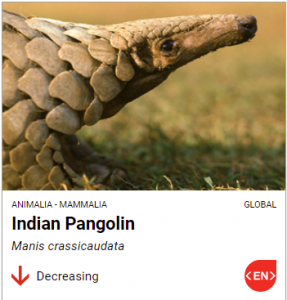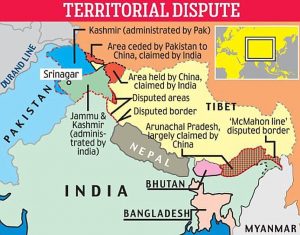THE ENVIRONMENT AND ECOLOGY
1. RADIO TAGGING OF INDIAN PANGOLIN
THE CONTEXT: The Odisha Forest and Environment Department has completed its first-ever radio-tagging of the Indian pangolin in an attempt to standardise the rehabilitation protocol for the animal in the State.
THE EXPLANATION:

- According to the forest department a male pangolin, which was rescued by the Paralakhemundi Forest Division November 2021, was radio-tagged and released in the Nandankanan Wildlife Sanctuary after treatment.
- “To standardise the rehabilitation protocol for such rescued animals, a radio-tagged Indian pangolin was released into the wild in Nandankanan Wildlife Sanctuary following soft release protocols and provision for post-release monitoring”.
- The animal was screened for parasites and diseases during a month-long quarantine at the Nandankanan Zoological Park (NZP), which is the only conservation breeding centre for Indian pangolins in the world.
- According to the forest officials, “the pangolin was found suitable for release in the wild. It gained 780 grams during quarantine and now weighs 14.740 kg. It is exhibiting normal behaviour. It is fitted with a VHF [very high frequency] radio transmitter, weighing 0.5% of its body weight, procured from advanced telemetry systems specialised in radio telemetry instruments”.
- After Madhya Pradesh, Odisha is the second State in the country to release a radio-tagged Indian pangolin into the wild. NZP authorities said the exercise was expected to reveal valuable information on the ecology, dispersal pattern, home range and survival of the reclusive animal.
What is Radio Tagging?
Radio-tracking is the technique of determining information about an animal through the use of radio signals from or to a device carried by the animal. Most radio tracking systems involve transmitters tuned to different frequencies (analogous to different AM/FM radio stations) that allow individual identification.
About Indian Pangolin
The Indian pangolin or thick-tailed pangolin is a solitary, shy, slow moving, nocturnal mammal, Unlike other pangolin species, the Indian pangolin does not often climb trees. Pangolins or scaly anteaters (order Pholidota, meaning ‘scaled animals’) are a group of unusual mammals with tough, protective keratin scales.
Distribution: Bangladesh, India, Nepal, Pakistan and Sri Lanka.
Threats:
- Once known to be found in large numbers, its population is rapidly declining in its range due to habitat loss and rampant poaching for its skin, scales, and meat.
- Pangolins are the most illegally traded mammals in the world and the Indian pangolin is the largest among eight pangolin species. The nocturnal animal lives in burrows and feed on ants and termites. In Odisha, seizures of pangolins and their scales have been made over the past few years.
Conservation status:
- All pangolin species are listed in Convention on International Trade in Endangered Species (CITES) Appendix I.
- In India, pangolins, both Indian and Chinese, are protected under Schedule 1 of the Wildlife (Protection) Act 1972
THE INDIAN ECONOMY
2. ELECTORAL BONDS
THE CONTEXT: Ahead of assembly elections in five states, the Union government approved the issuance of the 19th tranche of electoral bonds which will be open for sale from January 1 to 10 2022.
THE EXPLANATION:
- Electoral bonds have been pitched as an alternative to cash donations made to political parties as part of efforts to bring transparency in political funding. However, Opposition parties have been raising concerns about alleged opaqueness in funding through such bonds.
- The 29 specified SBI branches are in cities such as Lucknow, Shimla, Dehradun Kolkata, Guwahati, Chennai, Thiruvananthapuram, Patna, New Delhi, Chandigarh, Srinagar, Gandhinagar, Bhopal, Raipur, and Mumbai.
What are Electoral Bonds?
- The Government of India has notified the Electoral Bond Scheme 2018. As per provisions of the Scheme, Electoral Bonds may be purchased by a person who is a citizen of India or incorporated or established in India. A person being an individual can buy Electoral Bonds, either singly or jointly with other individuals.
- Only the Political Parties registered under Section 29A of the Representation of the People Act, 1951 (43 of 1951) and which secured not less than one percent of the votes polled in the last General Election to the House of the People or the Legislative Assembly of the State, shall be eligible to receive the Electoral Bonds. The Electoral Bonds shall be encashed by an eligible Political Party only through a Bank account with the Authorized Bank.
- State Bank of India (SBI), has been authorised to issue and encash Electoral Bonds through its 29 Authorized Branches ( as per list enclosed) e.f. 01.07.2021 to 10.07.2021.
- The Electoral Bonds shall be valid for fifteen calendar days from the date of issue and no payment shall be made to any payee Political Party if the Electoral Bond is deposited after expiry of the validity period. The Electoral Bond deposited by an eligible Political Party in its account shall be credited on the same day.

INTERNAL SECURITY
3. AFSPA EXTENDED IN NAGALAND
THE CONTEXT: The Government of India has extended the Armed Forces Special Powers Act, 1958 in Nagaland for another six months (June 30, 2022). The decision came days after the Home Ministry had instituted a high-level committee chaired by a Secretary-level officer for examining the possibility of AFSPA repeal in Nagaland.
THE EXPLANATION:
- The Central Government issued a notification in which it declared an entire state of Nagaland as a ‘disturbed area’ and extended the AFSPA, 1958 in the state for the period of another six months. Govt extending the Armed Forces act till June 30, 2022, stated that Nagaland’s ‘disturbed and dangerous’ situation has necessitated the use of armed forces in aid of the civil power. The Indian Army is also currently conducting a court of inquiry into an ambush that went wrong in Nagaland.
- The decision came three weeks after 6 innocent civilians in early December 2021, in the state were killed in an Army ambush and eight more in the violence that was triggered in Mon District, Nagaland
Govt demands repeal of the law
- In view of the improved situation in the Northeast state, the Nagaland government has been consistently taking a stand that the state must not be declared a ‘disturbed area’ and the entire Naga Society has been calling to repeal AFSPA.
- The Chief Minister while informing about the State govt’s clear stand on the law further added that the declaration of a state or any other area as the ‘disturbed area’ under AFSPA is made by the Central Government generally for a period of 6 months only at a time.
- The State Government has passed a resolution against the Armed Forces Special Act that has been adopted in the aftermath of the killing of 14 civilians by the security forces.
What is Armed Forces Special Powers Act (AFSPA)?

How is a region declared ‘disturbed’?
- Section (3) of the AFSPA empowers the governor of the state or Union territoryto issue an official notification in The Gazette of India, following which the Centre has the authority to send in armed forces for civilian aid.
- Once declared ‘disturbed’, the region has to maintain status quo for a minimum of three months, according to The Disturbed Areas (Special Courts) Act, 1976.

Criticism of AFSPA:
- Sec 4(a) in which army can shoot to kill, as it violates article 21 which gives right to life.
- Section 4(b) search without warrants violates right to liberty and article 22.
- Dispersion of civil assembly by armed forces under section 121 violates right to assembly
- No judicial magistrate permission required while arresting –violate article 22
- Overrides CrPC.
- Violation of human rights
- It alienates the people from army and then from the rest of India. A feeling of otherworldly is generated in their mind.
What should be done?
- Create committees at the district level with representatives of the army, administrators and the public which will report, assess and track complaints in that area.
- All investigations should be time bound reasons for the delay must be communicated with the aggrieved.
- Amendments In-Laws :The lacunae in the Act, as a result of definitional voids with respect to terms like “disturbed”, “dangerous” and “land forces” need to be amplified to ensure greater clarity.
- The onus of proving the alleged person as terrorists should lie with the forces. Sec 7 should be suitable amended to this effect.
4. CHINA ISSUES ‘OFFICIAL’ NAMES FOR 15 PLACES IN ARUNACHAL PRADESH
THE CONTEXT: China’s Ministry of Civil Affairs issued a statement stating that they have ‘standardised’ names for 15 places in Arunachal Pradesh, to be used on Chinese maps. This is the second time China has renamed the names of the places of Arunachal Pradesh.
THE EXPLANATION:
- China shares its 22,457 km land boundary with 14 countries including India, the third longest after the borders with Mongolia and Russia.
- The Ministry of External Affairs has dismissed the Chinese “invention”. According to the ministry ,“Arunachal Pradesh has always been, and will always be, an integral part of India. Assigning invented names to places in Arunachal Pradesh does not alter this fact.”
Why is China giving names to places that are in India?
- China claims some 90,000 sq km of Arunachal Pradesh as its territory. It calls the area “Zangnan” in the Chinese language and makes repeated references to “South Tibet”. Chinese maps show Arunachal Pradesh as part of China, and sometimes parenthetically refer to it as “so-called Arunachal Pradesh”.
- China makes periodic efforts to underline this unilateral claim to Indian territory. Giving Chinese names to places in Arunachal Pradesh is part of that effort.
“According to relevant regulations on the management of place names, the department has standardised some place names in China’s South Tibet region. We have released the first batch of the place names in South Tibet (six in total).
The latitude and longitude listed with the names showed those places as Tawang, KraDaadi, West Siang, Siang (where Mechuka or Menchuka is an emerging tourist destination), Anjaw, and Subansiri respectively.
These six places spanned the breadth of Arunachal Pradesh — “Wo’gyainling” in the west, “Bumo La” in the east and the other four located in the central part of the state.

What is China’s argument for claiming these areas?
- The People’s Republic of China disputes the legal status of the McMahon Line, the boundary between Tibet and British India that was agreed at the Simla Convention — officially the ‘Convention Between Great Britain, China, and Tibet’ — of 1914.
- China was represented at the Simla Convention by a plenipotentiary of the Republic of China, which had been declared in 1912 after the Qing dynasty was overthrown. (The present communist government came to power only in 1949, when the People’s Republic was proclaimed.) The Chinese representative did not consent to the Simla Convention, saying Tibet had no independent authority to enter into international agreements.
- The McMohan Line, named after Henry McMahon, the chief British negotiator at Shimla, was drawn from the eastern border of Bhutan to the Isu Razi pass on the China-Myanmar border. China claims territory to the south of the McMahon Line, lying in Arunachal Pradesh.
THE MISCELLANEOUS
5. SAHITYA AKADEMI AWARDS
THE CONTEXT: The Sahitya Akademi announced its prestigious “Sahitya Akademi Awards, YuvaPuraskar as well as Bal Sahitya Puraskar” for 2021 in various languages.
THE EXPLANATION:
- The Sahitya Akademy Award 2021 was given in 20 Indian languages.
- Namita Gokhale received it in English for her novel titled ‘Things to Leave Behind’.
Other winners include:
- Anuradha Sarma Pujari (Assamese)
- BratyaBasu (Bengali)
- Daya Prakash Sinha (Hindi)
- WaliMohdAseerKashtawari (Kashmiri)
- Khalid Hussain (Punjabi)
- Vindeshwari prasad Mishr “Vinay” (Sanskrit) etc.
Sahitya AkademiYuvaPuraskar 2021
- The Sahitya AkademiYuvaPuraskar 2021 was given in 22 Indian languages.
- Megha Majumdar won this award for her debut book ‘A Burning’, which was published in 2020. This book is about struggles of life in India.
- Megha Majumdar was born in India, but now lives in New York and works as an Editor in chief- Books at Catapult Story.
Other winners of the award include:
- Abhijit Bora (Assamese)
- Gourob Chakraborty (Bengali)
- DrashtiSoni (Gujarati)
- Himanshu Vajpai (Hindi)
- Mahesh Dahal (Nepali)
- SwetapadmaSatapathy (Sanskrit) etc.
Bal Sahitya Puraskar 2021
- The Bal Sahitya Puraskar 2021 was given in 22 Indian languages.
- Anita Vachharajani won the award in the English language. She was awarded for her children’s book titled ‘Amrita Sher-Gil: Rebel With A Paintbrush’.
Other winners include:
- Mrinal Chandra Kalita (Assamese)
- Sunirmal Chakraborty (Bengali)
- Devendra Mewari (Hindi)
- Majeed Majazi (Kashmiri) etc.
The Sahitya Akademi Award
- It is a literary honour in India, conferred annually by the Sahitya Akademi. Award is conferred on writers of the most outstanding books of literary merit, which are published in any of 24 major Indian languages and 22 languages that are listed in the Eighth Schedule of the Indian Constitution. The award was established in 1954.
THE PRELIMS PRACTICE QUESTION
| Q1. With reference to the Indus river system, of the following four rivers, three of them
pour into one of them which joins the Indus direct. Among the following, which one is such river that joins the indus direct? (a) Chenab (b) Jhelum (c) Ravi (d) Sutlej ANSWER FOR 30THDECEMBER 2021 Answer: B |




